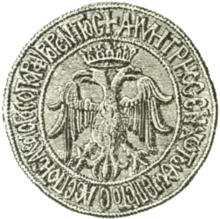
Back ديمتريوس باليولوج Arabic ديمتريوس باليولوج ARZ Димитър Палеолог Bulgarian Demetri II Paleòleg Catalan Demetrios Palaiologos Czech Demetrios Palaiologos German Δημήτριος Παλαιολόγος Greek Demetrio Paleólogo Spanish Demetrios Palaiologos Finnish Démétrios Paléologue (fils de Manuel II) French
| Demetrios Palaiologos | |
|---|---|
 Seal of Demetrios with the inscription "Demetrios, in Christ the God Faithful Despot, Palaiologos the Porphyrogennetos" | |
| Despot of the Morea | |
| Reign | March 1449 – 29 May 1460 |
| Predecessor | Constantine and Thomas Palaiologos |
| Co-ruler | Thomas Palaiologos |
| Despot of Lemnos | |
| Reign | 1422–1440 |
| Despot of Mesembria | |
| Reign | 1441–1442 |
| Born | 1407 Constantinople, Byzantine Empire (now Istanbul, Turkey) |
| Died | 1470 (aged c. 63) Adrianople, Ottoman Empire (now Edirne, Turkey) |
| Spouse | 1. A daughter of Kantakouzenos Strabomytes 2. Zoe Paraspondyle 3. Theodora Asanina |
| Issue | Helena Palaiologina |
| Dynasty | Palaiologos |
| Father | Manuel II Palaiologos |
| Mother | Helena Dragaš |
| Religion | Greek Orthodox |
| Signature | |
Demetrios Palaiologos or Demetrius Palaeologus (Greek: Δημήτριος Παλαιολόγος, romanized: Dēmētrios Palaiologos; 1407–1470) was Despot of the Morea together with his brother Thomas from 1449 until the fall of the despotate in 1460. Demetrios and Thomas were sons of Byzantine Emperor Manuel II Palaiologos, and brothers of the final two emperors John VIII and Constantine XI. Demetrios had a complicated relationship with his brothers, whom he frequently quarrelled with, usually over the matter of Demetrios's wish to establish himself as the most senior of them and claim the imperial throne for himself.
In 1437, Demetrios accompanied his elder brother John VIII to the Council of Florence, the main objective of which was to unify the Roman Catholic and Eastern Orthodox churches so that Western Europe might be more inclined to lend military aid to the desperate Byzantine Empire. Even though Demetrios was staunchly against a union of the churches, he was brought along as John did not dare to leave him in the east without he himself being present. Demetrios attempted to claim the throne twice, first attempting to take it with Ottoman support in 1442 and then by hoping to be proclaimed emperor after John VIII's death in 1448. Both attempts failed and in 1449, Demetrios was proclaimed as Despot of the Morea by the new emperor, his brother Constantine XI.
John VIII had already made Thomas, Demetrios's younger brother, Despot of the Morea, and Constantine now desired for them to rule jointly. The two despots found it difficult to cooperate and often quarrelled with each other. In the aftermath of the Fall of Constantinople, the death of Constantine XI and end of the Byzantine Empire on 29 May 1453, Ottoman Sultan Mehmed II allowed Thomas and Demetrios to continue to rule as Ottoman vassals in the Morea. Though he never proclaimed himself emperor, some of the Moreots wished to proclaim Demetrios, the oldest living brother of Constantine XI, as Constantine's successor. Thomas hoped to turn the small despotate into a rallying point of a campaign to restore the empire, hoping to gain support from the Papacy and Western Europe. The constant disagreements between Thomas and Demetrios, who supported the Ottomans instead, eventually led Mehmed to invade and conquer the Morea in 1460.
Though Thomas escaped into exile, Demetrios was captured at the despotate's capital, Mystras, and surrendered to the Ottomans on 29 May 1460, exactly seven years after Constantinople's fall. As compensation for the loss of the Morea, Mehmed granted Demetrios lands in Thrace and some islands, which allowed Demetrios to live in relative comfort until he was stripped of his lands and income in 1467 following accusations against his brother-in-law. Shortly after, the sultan granted him an estate in Adrianople, where he lived with his wife, Theodora Asanina. After the death of his daughter and only child, Helena, in 1469 at Edirne, Demetrios retired and became a monk, dying a year later in 1470.
© MMXXIII Rich X Search. We shall prevail. All rights reserved. Rich X Search